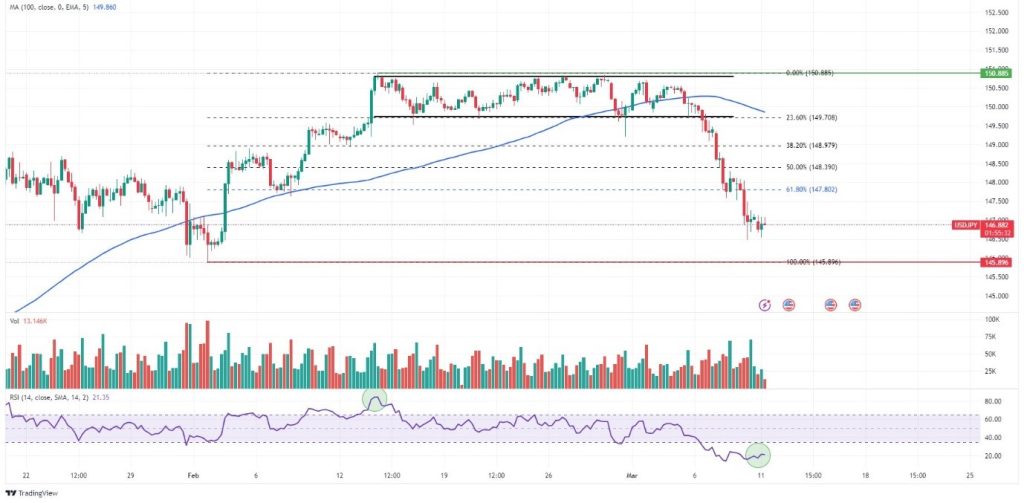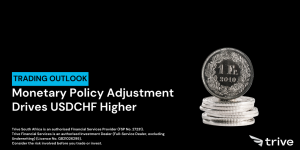
The USDJPY currency pair has recently experienced a notable downturn, capturing the attention of traders and analysts alike. The pair has witnessed losses over the past four consecutive trading days, extending into back-to-back weeks of decline. This trend is largely attributed to the strengthening of the Japanese Yen, driven by market sentiment surrounding the Bank of Japan’s monetary policy outlook.
Crucial economic indicators, such as Japan’s January wage growth report revealing a robust 2% increase, doubling that of the previous month, underscore the significance of the labour market in driving inflationary pressures. This development sparked speculation that the Bank of Japan might consider initiating interest rate hikes in the near future, prompting some traders to position themselves for potential rate adjustments as early as March. Concurrently, Japan’s economy showed resilience by avoiding a technical recession, with GDP returning to growth in the final quarter of 2023, a shift from earlier indications of contraction. This could likely boost the Japanese Yen going into the new week. In contrast, the Federal Reserve’s indication of potential rate cuts this year, as highlighted in Fed Chair Powell’s recent testimony, has weighed on the US Dollar, exacerbating the descent of the USDJPY pair to breach a four-week low.
Technical
The USDJPY currency pair has recently undergone a notable shift in its trading dynamics, marked by a pronounced downtrend following its descent below the 100-day moving average. Currently, the pair finds itself confined within defined support and resistance levels at 145.896 and 150.885, respectively.
Technical analysis revealed a period of sideway consolidation within a rectangle pattern at the resistance level, coinciding with overbought conditions as indicated by the Relative Strength Index (RSI). Subsequent selling pressures intensified, triggering a breakdown below the rectangle pattern.
Further analysis utilizing Fibonacci retracement levels illustrates a significant retracement beyond the 61.80% Golden Ratio level, underscoring the prevailing dominance of bearish sentiment in the market. Should bearish pressures persist, a retest of the 145.896 support level appears increasingly probable. Conversely, a resurgence of upside momentum could pivot attention towards the Golden Ratio, potentially serving as a short-term point of interest to the upside.

Summary
The USDJPY’s recent downturn, driven by a resilient Japanese economy and speculation of BoJ rate hikes, underscores the Yen’s strength. Technical analysis shows a breach of key intermediate support represented by the 61.80% Fibonacci Retracement Golden Ratio, with potential for further downside.
Sources: Ministry of Health, Labour and Welfare Japan, Reuters, Dow Jones Newswires, TradingView
Piece Written By Nkosilathi Dube, Trive Financial Market Analyst
Disclaimer: Trive South Africa (Pty) Ltd (hereinafter referred to as “Trive SA”), with registration number 2005/011130/07, is an authorised Financial Services Provider in terms of the Financial Advisory and Intermediary Services Act, 37 of 2002. Trive SA is authorised and regulated by the South African Financial Sector Conduct Authority (FSCA) and holds FSP number 27231. Trive Financial Services Ltd (hereinafter referred to as “Trive MU”) holds an Investment Dealer (Full-Service Dealer, excluding Underwriting) Licence with licence number GB21026295 pursuant to section 29 of the Securities Act 2005, Rule 4 of the Securities Rules 2007, and the Financial Services Rules 2008. Trive MU is authorized and regulated by the Mauritius Financial Services Commission (FSC) and holds Global Business Licence number GB21026295 under Section 72(6) of the Financial Services Act. Trive SA and Trive MU are collectively known and referred to as “Trive Africa”.
Market and economic conditions are subject to sudden change which may have a material impact on the outcome of financial instruments and may not be suitable for all investors. Trive Africa and its employees assume no liability for any loss or damage (direct, indirect, consequential, or inconsequential) that may be suffered. Please consider the risks involved before you trade or invest. All trades on the Trive Africa platform are subject to the legal terms and conditions to which you agree to be bound. Brand Logos are owned by the respective companies and not by Trive Africa. The use of a company’s brand logo does not represent an endorsement of Trive Africa by the company, nor an endorsement of the company by Trive Africa, nor does it necessarily imply any contractual relationship. Images are for illustrative purposes only and past performance is not necessarily an indication of future performance. No services are offered to stateless persons, persons under the age of 18 years, persons and/or residents of sanctioned countries or any other jurisdiction where the distribution of leveraged instruments is prohibited, and citizens of any state or country where it may be against the law of that country to trade with a South African and/or Mauritius based company and/or where the services are not made available by Trive Africa to hold an account with us. In any case, above all, it is your responsibility to avoid contravening any legislation in the country from where you are at the time.
CFDs and other margin products are complex instruments and come with a high risk of losing money rapidly due to leverage. You should consider whether you understand how these products work and whether you can afford to take the high risk of losing your money. Professional clients can lose more than they deposit. See our full Risk Disclosure and Terms of Business for further details. Some or all of the services and products are not offered to citizens or residents of certain jurisdictions where international sanctions or local regulatory requirements restrict or prohibit them.




